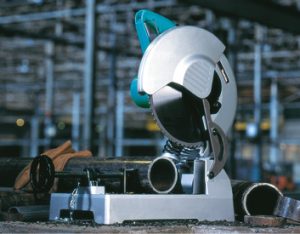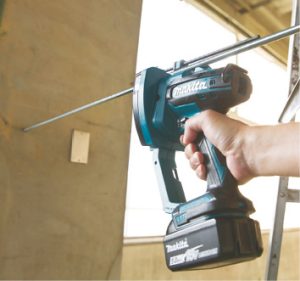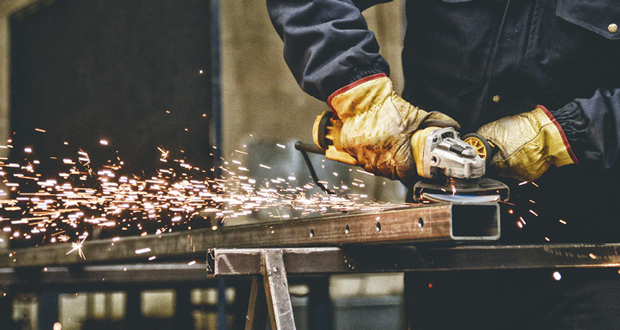 A wide range of maintenance and retrofit tasks require metal cutting but there are several health and safety considerations. Kevin Brannigan, Marketing Manager at Makita explores tools that offer cold and spark-free cutting
A wide range of maintenance and retrofit tasks require metal cutting but there are several health and safety considerations. Kevin Brannigan, Marketing Manager at Makita explores tools that offer cold and spark-free cutting
Whether its installing new or replacement pipework, fitting additional cable management to meet the evolving needs of building occupants or modifying ventilation ducting, there are many instances where maintenance operatives will need to cut metal products to size. However, traditional methods have their drawbacks. Manual cutting with hand tools is not only time-consuming but very hard work, especially where there are a large number of cuts that need to be completed.
The conventional labour-saving alternative is cutting using an abrasive wheel power tool. However, this comes with challenges. The sparks and hot metal debris produced present a potential fire hazard – so hot works risk assessments and safety measures are required. In addition, abrasive wheel tools also heat the metal itself, meaning there is a burn risk to those working with the material. The need to minimise the risk of fire typically means that the cutting must take place in a designated location, which will often be away from the work area, meaning wasted time moving the materials back and forth. The need to gain approval to carry out this type of work, while improving safety, does mean that teams are less able to be reactive to maintenance tasks.
However, there is an alternative. Mains powered and cordless cold cutting tools can provide the answer by reducing the risk of fire, improving safety for the user and those working nearby, and eliminating the need for a hot works permit in many cases. There are several options available to suit different tasks and requirements.
METAL SAWS
 A quality metal cut-off saw is ideal for cutting materials such as metal pipes, metal conduit, steel cable trays and steel trunking. There are broadly two types of saw, stationary metal cut-off saws and portable circular saws designed specifically for metal. These saws cut far quicker when compared with manual methods but without producing hot sparks, and leave the material cool to the touch, eliminating the burn risk. They also achieve burr free edges meaning less additional work is required once the cut has been made.
A quality metal cut-off saw is ideal for cutting materials such as metal pipes, metal conduit, steel cable trays and steel trunking. There are broadly two types of saw, stationary metal cut-off saws and portable circular saws designed specifically for metal. These saws cut far quicker when compared with manual methods but without producing hot sparks, and leave the material cool to the touch, eliminating the burn risk. They also achieve burr free edges meaning less additional work is required once the cut has been made.
The nature of the stationary cut-off saws means they are most suitable for cutting narrower materials such as pipe and conduit but can do so with a much higher degree of accuracy compared with a handheld power tool. This is especially true when cutting angles on materials where the saw features an easily adjustable clamp to hold the material securely in place.
However, it is important to look carefully at the options available to ensure the tool offers the quality and versatility required. A product that allows exact angled cuts to be achieved easily is always recommended. It is also important to look for a saw that has a large capacity to ensure it can be used for a wide range of tasks.
For tasks that require more flexibility, there are hand-held metal circular saws. These are available in a range of blade sizes depending on the requirements, and as cordless versions. Where flexibility and agile working is a priority, cordless has many benefits. It provides, easier, simpler working with no need to secure access to a power source. It is also safer as it removes a potential trip hazard in the workspace and streamlines the task as there is no need to plan and manage the safe routing of cables.
THREADED ROD CUTTERS
 For threaded rod, often used for supporting ducting and ceiling mounted cable management, there are also cordless tools available for cold and spark-free cutting. Threaded rod cutters use a simple, safe and reliable shearing action to cut the rod to the required length. One of the advantages of this over other cutting methods is that it leaves a clean, burr free edge. This means it is easy to immediately attach nuts and other threaded fixings without the need to file the newly cut edge.
For threaded rod, often used for supporting ducting and ceiling mounted cable management, there are also cordless tools available for cold and spark-free cutting. Threaded rod cutters use a simple, safe and reliable shearing action to cut the rod to the required length. One of the advantages of this over other cutting methods is that it leaves a clean, burr free edge. This means it is easy to immediately attach nuts and other threaded fixings without the need to file the newly cut edge.
Some of the features to look out for when selecting a threaded rod cutter include the sizes of rod that can be cut, and depth gauges to allow quick and accurate cutting. Another useful feature is easy and fast blade change when working with different sizes of threaded rod. It is also important to look at the efficiency of the tool and therefore the number of cuts per battery charge. As an example, using a 5.0 Ah 18V battery the Makita DSC102 will achieve approximately 1700 cuts.
Cold, spark-free cutting of commonly used metal products can help make tasks safer for those working with the materials as well as minimising the risk of fire. These tools also make the work quicker, easier, cleaner and often more accurate than other approaches.





